Zinc Binding to Fulvic acids: Assessing the Impact of pH, Metal Concentrations and Chemical Properties of Fulvic Acids on the Mechanism and Stability of Formed Soluble Complexes
Abstract
1. Introduction
2. Results and Discussion
2.1. Fulvic Acids
2.2. Fluorescence Properties of FAs
2.3. Fluorescent Quenching Titration in the Analysis of Zn(II) Binding Properties of FAs
2.4. Quantification of the FA-Zn(II) Binding Process
2.5. FTIR Spectra of FA-Zn(II) Compounds
2.6. Zinc-Protons Competitive Interactions
2.7. The Importance of the FA-Zn(II) Interaction Mechanism for Environment
3. Materials and Methods
3.1. Fulvic Acids
3.2. Fluorescence Measurements
3.3. FTIR Measurements
3.4. Metal-Proton Exchange Equilibria
3.5. Statistical Analysis
4. Conclusions
Author Contributions
Funding
Conflicts of Interest
References
- Zhao, J.; Nelson, D.J. Fluorescence study of the interaction of Suwannee River fulvic acid with metal ions and Al3+-metal ion competition. J. Inorg. Biochem. 2005, 99, 383–396. [Google Scholar] [CrossRef]
- Wu, J.; Wu, M.; Li, C.; Yu, G. Long-Term Fertilization Modifies the Structures of Soil Fulvic Acids and Their Binding Capability with Al. PLoS ONE 2014, 9, e105567. [Google Scholar] [CrossRef][Green Version]
- Wu, J.; West, L.J.; Stewart, D.I. Effect of humic substances on Cu(II) solubility in kaolin-sand soil. J. Hazard. Mater. 2002, 94, 223–238. [Google Scholar] [CrossRef]
- Santos, A.M.P.; Bertoli, A.C.; Borges, A.C.C.P.; Gomes, R.A.B.; Garcia, J.S.; Trevisan, M.G. New Organomineral complex from humic substances extracted from poultry wastes: Synthesis, characterization and controlled release study. J. Braz. Chem. Soc. 2018, 29, 140–150. [Google Scholar] [CrossRef]
- Tinti, A.; Tugnoli, V.; Bonora, S.; Francioso, O. Recent applications of vibrational mid-infrared (IR) spectroscopy for studying soil components: A review. J. Cent. Eur. Agric. 2015, 16, 1–22. [Google Scholar] [CrossRef]
- Gungor, E.B.O.; Bekbölet, M. Zinc release by humic and fulvic acid as influenced by pH, complexation and DOC sorption. Geoderma 2010, 159, 131–138. [Google Scholar] [CrossRef]
- Boguta, P.; Sokołowska, Z. Interactions of Humic Acids with Metals; Bohdan Dobrzański Institute of Agrophysics Polish Academy of Sciences: Lublin, Poland, 2013; ISBN 9788578110796. [Google Scholar]
- Hernández-Montoya, V.; Alvarez, L.H.; Montes-Morán, M.A.; Cervantes, F.J. Reduction of quinone and non-quinone redox functional groups in different humic acid samples by Geobacter sulfurreducens. Geoderma 2012, 183–184, 25–31. [Google Scholar]
- Huang, S.; Wang, Y.; Cao, L.; Pi, K.; Yu, M.; Even, E. Multidimensional spectrofluorometry characterization of dissolved organic matter in arsenic-contaminated shallow groundwater. J. Env. Sci. Heal. Part A Toxic/Hazard. Subst. Env. Eng. 2012, 47, 1446–1454. [Google Scholar] [CrossRef]
- Wang, J.; Lü, C.; He, J.; Zhao, B. Binding characteristics of Pb2+ to natural fulvic acid extracted from the sediments in Lake Wuliangsuhai, Inner Mongolia plateau, P.R. China. Env. Earth Sci. 2016, 75, 758–768. [Google Scholar]
- Song, F.; Wu, F.; Feng, W.; Tang, Z.; Giesy, J.P.; Guo, F.; Shi, D.; Liu, X.; Qin, N.; Xing, B.; et al. Fluorescence regional integration and differential fluorescence spectroscopy for analysis of structural characteristics and proton binding properties of fulvic acid sub-fractions. J. Env. Sci. (China) 2018, 74, 116–125. [Google Scholar] [CrossRef]
- Ray, S.K.; Barman, K.K.; Mukhopadhyay, D. Stability of organo-zinc complex in application of inorganic and organic nutrients to rice (Oryza sativa) growing soils of West Bengal (India). Int. J. Chem. Stud. 2018, 6, 2157–2164. [Google Scholar]
- Da Silva, R.R.; Lucena, G.N.; MacHado, Â.F.; De Freitas, G.A.; Matos, A.T.; Abrahão, W.A.P. Spectroscopic and elementary characterization of humic substances in organic substrates. Comun. Sci. 2018, 9, 264–274. [Google Scholar] [CrossRef]
- Bertoli, A.C.; Garcia, J.S.; Trevisan, M.G.; Ramalho, T.C.; Freitas, M.P. Interactions fulvate-metal (Zn2+, Cu2+ and Fe2+): Theoretical investigation of thermodynamic, structural and spectroscopic properties. BioMetals 2016, 29, 275–285. [Google Scholar] [CrossRef]
- Curie, C.; Briat, J.F. Iron transport and signaling in plants. Annu. Biol. 2003, 54, 183–206. [Google Scholar]
- Zhu, W.; Yao, W.; Zhang, Z.; Wu, Y. Heavy metal behavior and dissolved organic matter (DOM) characterization of vermicomposted pig manure amended with rice straw. Env. Sci. Pollut. Res. 2014, 21, 12684–12692. [Google Scholar] [CrossRef] [PubMed]
- Mladenov, N.; Zheng, Y.; Simone, B.; Bilinski, T.M.; McKnight, D.M.; Nemergut, D.; Radloff, K.A.; Rahman, M.M.; Ahmed, K.M. Dissolved Organic Matter Quality in a Shallow Aquifer of Bangladesh: Implications for Arsenic Mobility. Env. Sci. Technol. 2015, 49, 10815–10824. [Google Scholar] [CrossRef] [PubMed]
- Inam, M.A.; Khan, R.; Park, D.R.; Khan, S.; Uddin, A.; Yeom, I.T. Complexation of antimony with natural organic matter: Performance evaluation during coagulation-flocculation process. Int. J. Env. Res. Public Health 2019, 16, 1092. [Google Scholar] [CrossRef]
- Fakour, H.; Lin, T.F. Experimental determination and modeling of arsenic complexation with humic and fulvic acids. J. Hazard. Mater. 2014, 279, 569–578. [Google Scholar] [CrossRef]
- Pinto, A.P.; Mota, A.M.; De Varennes, A.; Pinto, F.C. Influence of organic matter on the uptake of cadmium, zinc, copper and iron by sorghum plants. Sci. Total Env. 2004, 326, 239–247. [Google Scholar] [CrossRef]
- He, Y.; Men, B.; Yang, X.; Li, Y.; Xu, H.; Wang, D. Relationship between heavy metals and dissolved organic matter released from sediment by bioturbation/bioirrigation. J. Env. Sci. (China) 2019, 75, 216–223. [Google Scholar] [CrossRef]
- Cheng, T.; Allen, H.E. Comparison of zinc complexation properties of dissolved natural organic matter from different surface waters. J. Env. Manag. 2006, 80, 222–229. [Google Scholar] [CrossRef] [PubMed]
- Szatanik-Kloc, A.; Warchulska, P.; Józefaciuk, G. Changes in variable charge and acidity of rye (Secale cereale L.) roots surface under Zn-stress. Acta Physiol. Plant. 2009, 31, 59–64. [Google Scholar] [CrossRef]
- Kabata-Pendias, A. Trace Elements in Soils and Plants: Fourth Edition; CRC Press/Taylor & Francis Group: Boca Raton, FL, USA, 2010; ISBN 9781420093704. [Google Scholar]
- Yun, S.W.; Yu, C. Immobilization of Cd, Zn, and Pb from soil treated by limestone with variation of pH using a column test. J. Chem. 2015, 2015, 1–8. [Google Scholar] [CrossRef][Green Version]
- Zhang, T.; Wang, T.; Lu, Y. Study of the interactions of dissolved organic matter with zinc ion and the impact of competitive metal ions (Ca2+ and Mg2+) by in situ absorbance. Env. Geochem. Health 2018, 40, 1979–1986. [Google Scholar] [CrossRef] [PubMed]
- Boguta, P.; Sokołowska, Z. Interactions of Zn(II) Ions with Humic Acids Isolated from Various Type of Soils. Effect of pH, Zn Concentrations and Humic Acids Chemical Properties. PLoS ONE 2016, 11, e0153626. [Google Scholar] [CrossRef] [PubMed]
- Boguta, P.; Pieczywek, P.M.; Sokołowska, Z. A comparative study of the application of fluorescence excitation-emission matrices combined with parallel factor analysis and nonnegative matrix factorization in the analysis of Zn complexation by humic acids. Sensors 2016, 16, 1760. [Google Scholar] [CrossRef]
- Krężel, A.; Maret, W. The biological inorganic chemistry of zinc ions. Arch. Biochem. Biophys. 2016, 611, 3–19. [Google Scholar] [CrossRef]
- El-Taib Heakal, F.; Abd-Ellatif, W.R.; Tantawy, N.S.; Taha, A.A. Impact of pH and temperature on the electrochemical and semiconducting properties of zinc in alkaline buffer media. Rsc Adv. 2018, 8, 3816–3827. [Google Scholar] [CrossRef]
- Yan, M.; Fu, Q.; Li, D.; Gao, G.; Wang, D. Study of the pH influence on the optical properties of dissolved organic matter using fluorescence excitation-emission matrix and parallel factor analysis. J. Lumin. 2013, 142, 103–109. [Google Scholar] [CrossRef]
- Timko, S.A.; Gonsior, M.; Cooper, W.J. Influence of pH on fluorescent dissolved organic matter photo-degradation. Water Res. 2015, 85, 266–274. [Google Scholar] [CrossRef]
- Pace, M.L.; Reche, I.; Cole, J.J.; Fernández-Barbero, A.; Mazuecos, I.P.; Prairie, Y.T. pH change induces shifts in the size and light absorption of dissolved organic matter. Biogeochemistry 2012, 108, 109–118. [Google Scholar] [CrossRef]
- Xiong, J.; Koopal, L.K.; Tan, W.; Fang, L.; Wang, M.; Zhao, W.; Liu, F.; Zhang, J.; Weng, L. Lead binding to soil fulvic and humic acids: NICA-donnan modeling and XAFS spectroscopy. Env. Sci. Technol. 2013, 47, 11634–11642. [Google Scholar] [CrossRef] [PubMed]
- Boguta, P.; Sokołowska, Z.; Skic, K. Use of thermal analysis coupled with differential scanning calorimetry, quadrupole mass spectrometry and infrared spectroscopy (TG-DSC-QMS-FTIR) to monitor chemical properties and thermal stability of fulvic and humic acids. PLoS ONE 2017, 12, e0189653. [Google Scholar] [CrossRef] [PubMed]
- El-table, A.S.; Wassel, M.A.; Arafa, M.M. Preparation and investigation of fulvic acid and its metal derivative complexes with application. Int. J. Sci. Eng. Res. 2017, 8, 1663–1679. [Google Scholar]
- Amir, S.; Jouraiphy, A.; Meddich, A.; El Gharous, M.; Winterton, P.; Hafidi, M. Structural study of humic acids during composting of activated sludge-green waste: Elemental analysis, FTIR and 13 C NMR. J. Hazard. Mater. 2010, 177, 524–529. [Google Scholar] [CrossRef] [PubMed]
- Maia, C.D.F.; Fukamach, C.R.B.; Piccolo, A.; Mangrich, A.S. EPR and DRIFT spectroscopic characterization of humic fractions during composting of sawdust and paper mill sludge. Pesqui. Florest. Bras. 2012, 32, 1–6. [Google Scholar] [CrossRef]
- Boguta, P.; Sokołowska, Z. Statistical relationship between selected physicochemical properties of peaty-muck soils and their fraction of humic acids. Int. Agrophysics 2014, 28, 269–278. [Google Scholar] [CrossRef]
- Uyguner, C.S.; Bekbolet, M. Implementation of spectroscopic parameters for practical monitoring of natural organic matter. Desalination 2005, 176, 47–55. [Google Scholar] [CrossRef]
- De Oliveira, L.K.; de Almeida Melo, C.; Fraceto, L.F.; Friese, K.; Rosa, A.H. Interaction of arsenic species with tropical river aquatic humic substances enriched with aluminum and iron. Env. Sci. Pollut. Res. 2016, 23, 6205–6216. [Google Scholar] [CrossRef]
- Xie, Z.; Guan, W. Research on Fluorescence Spectroscopy Characteristics of Dissolved Organic Matter of Landfill Leachate in the Rear Part of Three Gorges Reservoir. J. Spectrosc. 2015, 2015, 1–9. [Google Scholar] [CrossRef]
- Chen, J.; Gu, B.; LeBoeuf, E.J.; Pan, H.; Dai, S. Spectroscopic characterization of the structural and functional properties of natural organic matter fractions. Chemosphere 2002, 48, 59–68. [Google Scholar] [CrossRef]
- Wang, Z.; Wu, Z.; Tang, S. Characterization of dissolved organic matter in a submerged membrane bioreactor by using three-dimensional excitation and emission matrix fluorescence spectroscopy. Water Res. 2009, 43, 1533–1540. [Google Scholar] [CrossRef] [PubMed]
- Plaza, C.; Brunetti, G.; Senesi, N.; Polo, A. Molecular and quantitative analysis of metal ion binding to humic acids from sewage sludge and sludge-amended soils by fluorescence spectroscopy. Env. Sci. Technol. 2006, 40, 917–923. [Google Scholar] [CrossRef] [PubMed]
- Bertoncini, E.I.; D’Orazio, V.; Senesi, N.; Mattiazzo, M.E. Fluorescence analysis of humic and fulvic acids from two Brazilian oxisols as affected by biosolid amendment. Anal. Bioanal. Chem. 2005, 381, 1281–1288. [Google Scholar] [CrossRef] [PubMed]
- Olendzki, R.N.; Ignácio, A.C.; Mangrich, A.S. The use of total luminescence spectroscopy in the investigation of the effects of different rice management practices on humic substances of a planosol. Rev. Bras. Ciência Do Solo 2009, 33, 1147–1152. [Google Scholar] [CrossRef]
- Hudson, N.; Baker, A.; Reynolds, D. Fluorescence analysis of dissolved organic matter in natural, waste and polluted waters—A review. River. Res. Applic. 2007, 23, 631–649. [Google Scholar] [CrossRef]
- Patel-Sorrentino, N.; Mounier, S.; Benaim, J.Y. Excitation-emission fluorescence matrix to study pH influence on organic matter fluorescence in the Amazon basin rivers. Water Res. 2002, 36, 2571–2581. [Google Scholar] [CrossRef]
- Wang, R.; Yang, S.; Fang, J.; Wang, Z.; Chen, Y.; Zhang, D.; Yang, C. Characterizing the interaction between antibiotics and humic acid by fluorescence quenching method. Int. J. Env. Res. Public Health 2018, 15, 1458. [Google Scholar] [CrossRef]
- Berkovic, A.M.; García Einschlag, F.S.; Gonzalez, M.C.; Pis Diez, R.; Mártire, D.O. Evaluation of the Hg2+ binding potential of fulvic acids from fluorescence excitation-emission matrices. Photochem. Photobiol. Sci. 2013, 12, 384–392. [Google Scholar] [CrossRef]
- Orsetti, S.; Marco-Brown, J.L.; Andrade, E.M.; Molina, F.V. Pb(II) binding to humic substances: An equilibrium and spectroscopic study. Env. Sci. Technol. 2013, 47, 8325–8333. [Google Scholar] [CrossRef]
- Boguta, P.; D’Orazio, V.; Sokołowska, Z.; Senesi, N. Effects of selected chemical and physicochemical properties of humic acids from peat soils on their interaction mechanisms with copper ions at various pHs. J. Geochem. Explor. 2016, 168, 119–126. [Google Scholar] [CrossRef]
- Sokołowska, Z.; Szajdak, L.; Boguta, P. Effect of phosphates on dissolved organic matter release from peat-muck soils. Int. Agrophysics 2011, 25, 173–180. [Google Scholar]
- Boguta, P.; Sokołowska, Z. Influence of phosphate ions on buffer capacity of soil humic acids. Int. Agrophysics 2012, 26, 7–14. [Google Scholar] [CrossRef]
- Sahu, S.; Banerjee, D.K. Complexation of Copper (II), Cadmium (II) and Lead (II) with Humic and Fulvic Acids of Yamuna River Sediments. In Chemistry for the Protection of the Environment 2; Pawłowski, L., Lacy, W.J., Uchrin, C.G., Dudzińska, M.R., Eds.; Springer: Boston, MA, USA, 1996. [Google Scholar]
- Li, H.; Wang, J.; Zhao, B.; Gao, M.; Shi, W.; Zhou, H.; Xie, Z.; Zhou, B.; Lü, C.; He, J. The role of major functional groups: Multi-evidence from the binding experiments of heavy metals on natural fulvic acids extracted from lake sediments. Ecotoxicol. Env. Saf. 2018, 162, 514–520. [Google Scholar] [CrossRef]
- Wu, F.; Cai, Y.; Evans, D.; Dillon, P. Complexation between Hg(II) and dissolved organic matter in stream waters: An application of fluorescence spectroscopy. Biogeochemistry 2004, 71, 339–351. [Google Scholar] [CrossRef]
- Fu, Q.; Pan, X.; Zhang, D.; Zhou, B. Effects of heat treatment on fluorescence properties of humic substances from sandy soil in arid land and their Hg(II) binding behaviors. Env. Earth Sci. 2012, 66, 2273–2279. [Google Scholar] [CrossRef]
- Esteves Da Silva, J.C.G.; MacHado, A.A.S.C.; Oliveira, C.J.S.; Pinto, M.S.S.D.S. Fluorescence quenching of anthropogenic fulvic acids by Cu(II), Fe(III) and UO2/2+. Talanta 1998, 45, 1155–1165. [Google Scholar] [CrossRef]
- Chen, W.; Habibul, N.; Liu, X.Y.; Sheng, G.P.; Yu, H.Q. FTIR and synchronous fluorescence heterospectral two-dimensional correlation analyses on the binding characteristics of copper onto dissolved organic matter. Env. Sci. Technol. 2015, 49, 2052–2058. [Google Scholar] [CrossRef]
- Hays, M.D.; Ryan, D.K.; Pennell, S. A Modified Multisite Stern-Volmer Equation for the Determination of Conditional Stability Constants and Ligand Concentrations of Soil Fulvic Acid with Metal Ions. Anal. Chem. 2004, 76, 848–854. [Google Scholar] [CrossRef]
- Enev, V.; Türkeová, I.; Szewieczková, J.; Doskočil, L.; Klučáková, M. Fluorescence analysis of Cu(II), Pb(II) and Hg(II) ion binding to humic and fulvic acids. Mater. Sci. Forum 2016, 851, 135–140. [Google Scholar] [CrossRef]
- Piana, M.J.; Zahir, K.O. Investigation of metal ions binding of humic substances using fluorescence emission and synchronous-scan spectroscopy. J. Env. Sci. Heal. Part B Pestic. Food Contam. Agric. Wastes 2000, 35, 87–102. [Google Scholar] [CrossRef]
- Garcia-Mina, J.M. Stability, solubility and maximum metal binding capacity in metal-humic complexes involving humic substances extracted from peat and organic compost. Org. Geochem. 2006, 37, 1960–1972. [Google Scholar] [CrossRef]
- Wei, J.; Han, L.; Song, J.; Chen, M. Evaluation of the interactions between water extractable soil organic matter and metal cations (Cu(II), Eu(III)) using excitation-emission matrix combined with parallel factor analysis. Int. J. Mol. Sci. 2015, 16, 14464–14476. [Google Scholar] [CrossRef] [PubMed]
- Kawalec-Pietrenko, B.; Konopacka-Łyskawa, D.; Rybarczyk, P. Porównanie przebiegów równolegle zachodzących flotacji jonów cynku i miedzi. Inżynieria I Apar. Chem. 2011, 5, 50–51. [Google Scholar]
- Jayaganesh, S.; Senthurpandian, V.K. Extraction and characterization of humic and fulvic acids from latosols under tea cultivation in South India. Asian J. Earth Sci. 2010, 3, 130–135. [Google Scholar] [CrossRef][Green Version]
- Sirotiak, M.; Bartošová, A. Changes in Structure and Content Humic Substances in Soil During the Laboratory Simulated Fires. Trans. Všb–Tech. Univ. Ostrav. Saf. Eng. Ser. 2016, 11, 42–48. [Google Scholar] [CrossRef][Green Version]
- Balachandran, V.; Janaki, A.; Nataraj, A. Theoretical investigations on molecular structure, vibrational spectra, HOMO, LUMO, NBO analysis and hyperpolarizability calculations of thiophene-2-carbohydrazide. Spectrochim. Acta-Part A Mol. Biomol. Spectrosc. 2014, 118, 321–330. [Google Scholar] [CrossRef]
- Ahmed, Z.; Arif, S.; Muhammad, M. FTIR-A Didactic Approach for the Study of Humic Acid-Chromium Chelation During the Environmental Remediation. Pak. J. Sci. Ind. Res. Ser. A Phys. Sci. 2013, 56, 1–5. [Google Scholar]
- Jerzykiewicz, M. The effect of Hg(II) ions on the free radicals of humic substances and their model compounds. Chemosphere 2013, 92, 445–450. [Google Scholar] [CrossRef]
- Da Costa Saab, S.; Carvalho, E.R.; Filho, R.B.; De Moura, M.R.; Martin-Neto, L.; Mattoso, L.H.C. pH effect in aquatic fulvic acid from a Brazilian River. In Proceedings of the Meeting of the International Humic Substances Society; González-Pérez, J.A., González-Vila, F.J., Almendros, G., Eds.; 2010; pp. 29–31. [Google Scholar]
- Adriano, D.C. Biogeochemistry of Trace Metals; CRC Press: Boca Raton, FL, USA, 2017. [Google Scholar]
- Nara, M.; Morii, H.; Tanokura, M. Coordination to divalent cations by calcium-binding proteins studied by FTIR spectroscopy. Biochim. Biophys. Acta-Biomembr. 2013, 1828, 2319–2327. [Google Scholar] [CrossRef]
- Nakamoto, K. Infrared and Raman Spectra of Inorganic and Coordination Compounds: Part A: Theory and Applications in Inorganic Chemistry: Sixth Edition; John Wiley & Sons, Inc: Hoboken, NJ, USA, 2008; ISBN 9780471743392. [Google Scholar]
- Tipping, E. Cation Binding by Humic Substances; Cambridge University Press: Cambridge, UK, 2002. [Google Scholar]
- Alloway, B.J. Heavy Metals in Soils Trace Metals and Metalloids in Soils and Their Bioavailability; Springer: Dordrecht, The Netherlands, 2013; ISBN 9789400744691. [Google Scholar]
- Zhang, Z.; Lü, C.; He, J.; Gao, M.; Zhao, B.; Zhou, B.; Guo, J.; Zhou, H.; Liu, X.; Li, Z.; et al. Nature differences of fulvic acid fractions induced by extracted sequence as explanatory factors for binding characteristics of Cu2+. Chemosphere 2018, 191, 458–466. [Google Scholar] [CrossRef] [PubMed]
- Chassapis, K.; Roulia, M.; Nika, G. Fe(III)-humate complexes from Megalopolis peaty lignite: A novel eco-friendly fertilizer. Fuel 2010, 89, 1480–1484. [Google Scholar] [CrossRef]
- Tan, W.; Xiong, J.; Li, Y.; Wang, M.; Weng, L.; Koopal, L.K. Proton binding to soil humic and fulvic acids: Experiments and NICA-Donnan modeling. Colloids Surf. A Phys. Eng. Asp. 2013, 436, 1152–1158. [Google Scholar] [CrossRef]
- Habiby, H.; Afyuni, M.; Khoshgoftarmanesh, A.H.; Schulin, R. Effect of preceding crops and their residues on availability of zinc in a calcareous Zn-deficient soil. Biol. Fertil. Soils 2014, 50, 1061–1067. [Google Scholar] [CrossRef]
- Degryse, F.; Verma, V.K.; Smolders, E. Mobilization of Cu and Zn by root exudates of dicotyledonous plants in resin-buffered solutions and in soil. Plant Soil 2008, 306, 69–84. [Google Scholar] [CrossRef]
- Aghili, F.; Gamper, H.A.; Eikenberg, J.; Khoshgoftarmanesh, A.H.; Afyuni, M.; Schulin, R.; Jansa, J.; Frossard, E. Green manure addition to soil increases grain zinc concentration in bread wheat. PLoS ONE 2014, 9, e0101487. [Google Scholar] [CrossRef]
- Brahmia, O. Humic substances and napropamide interactions in aqueous solution: A fluorescence spectroscopy study. J. Mater. Env. Sci. 2016, 7, 1948–1957. [Google Scholar]
- Hernández, D.; Plaza, C.; Senesi, N.; Polo, A. Detection of Copper(II) and zinc(II) binding to humic acids from pig slurry and amended soils by fluorescence spectroscopy. Env. Pollut. 2006, 143, 212–220. [Google Scholar] [CrossRef]
- Silveira, M.L.A.; Alleoni, L.R.F.; Guilherme, L.R.G. Biosolids and heavy metals in soils. Sci. Agric. 2003, 60, 793–806. [Google Scholar] [CrossRef]
- Swift, R.S. Organic matter characterization. In Methods of Soil Analysis. Part 3. Chemical Methods; Sparks, D.L., Page, A.L., Helmke, P.A., Loeppert, R.A., Soltanpour, P.N., Tabatabai, M.A., Johnston, C.T., Sumner, M.E., Eds.; Soil Sci. Soc. Am.: Madison, WI, USA, 1996; pp. 1018–1020. ISBN 0891188258. [Google Scholar]
Sample Availability: Samples of the soils used for the studies are available from the authors. |
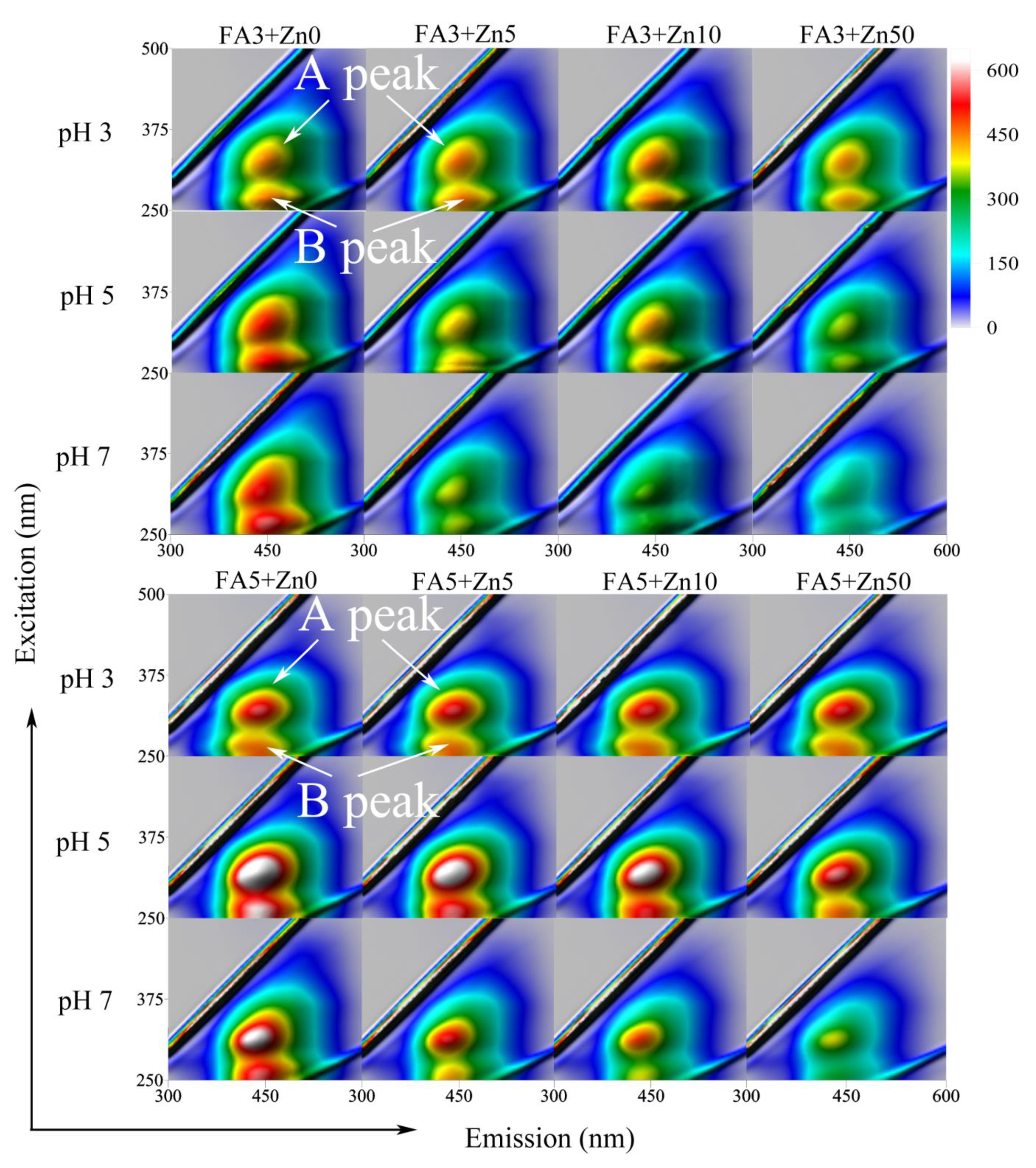
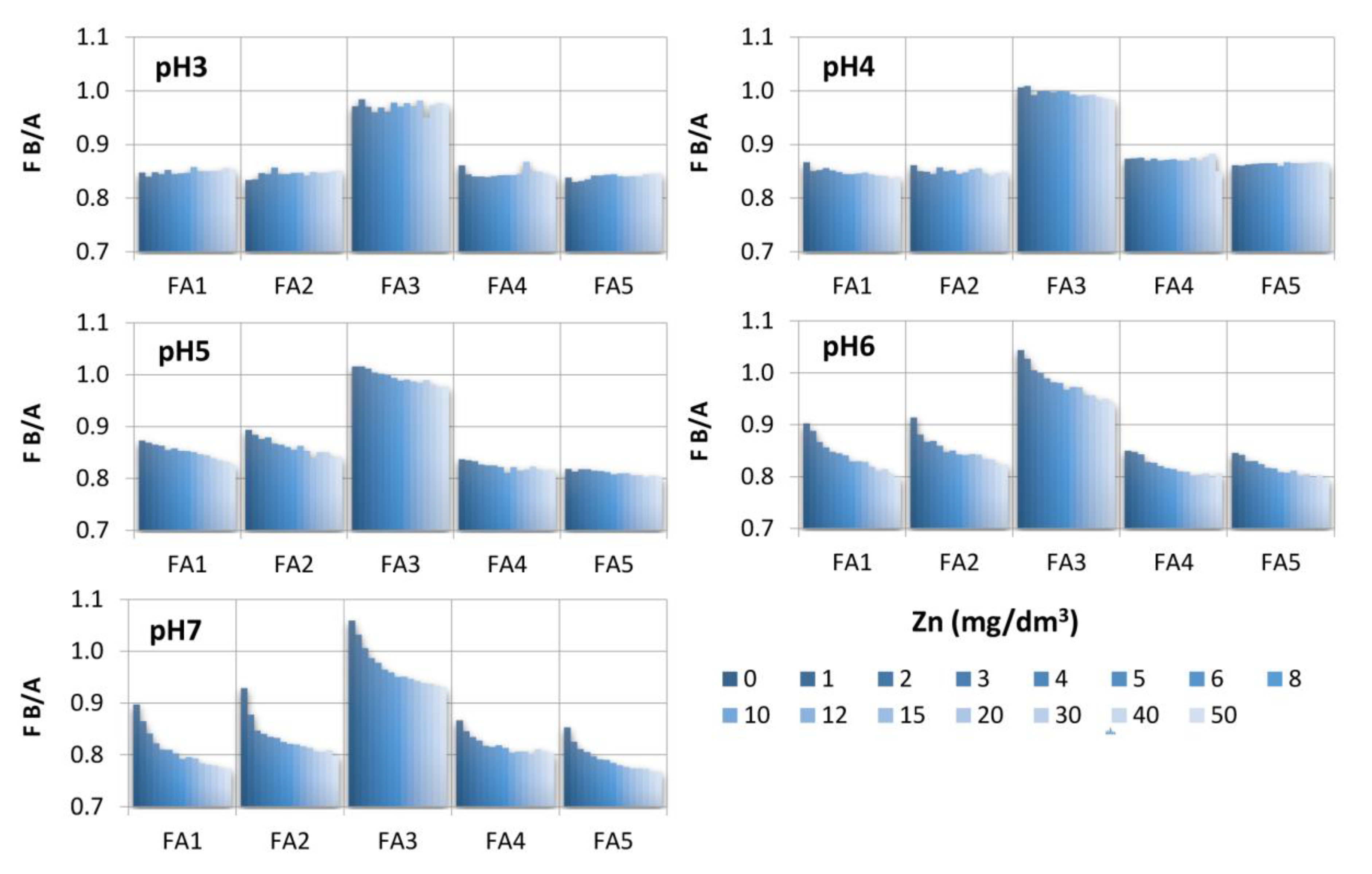
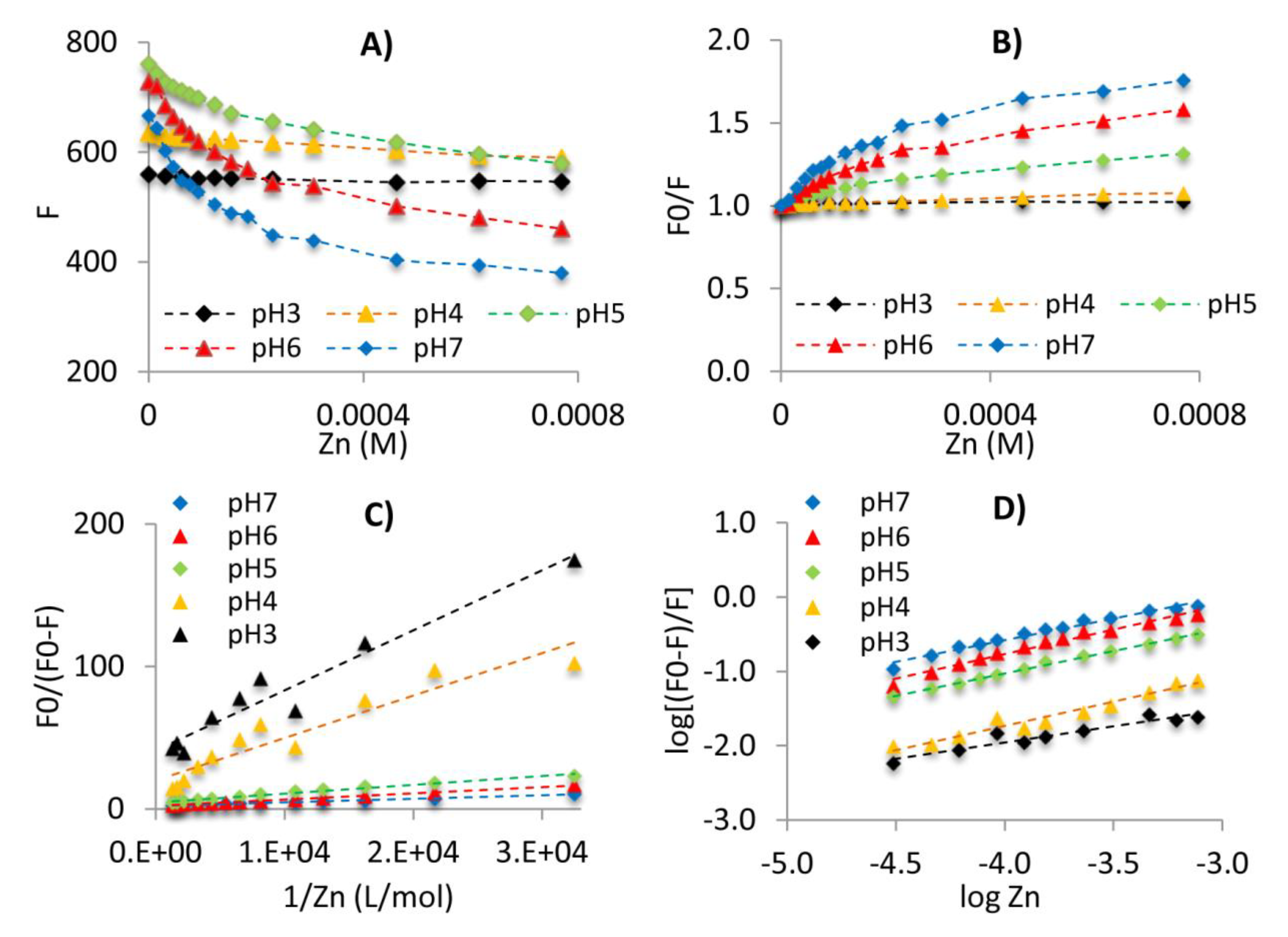
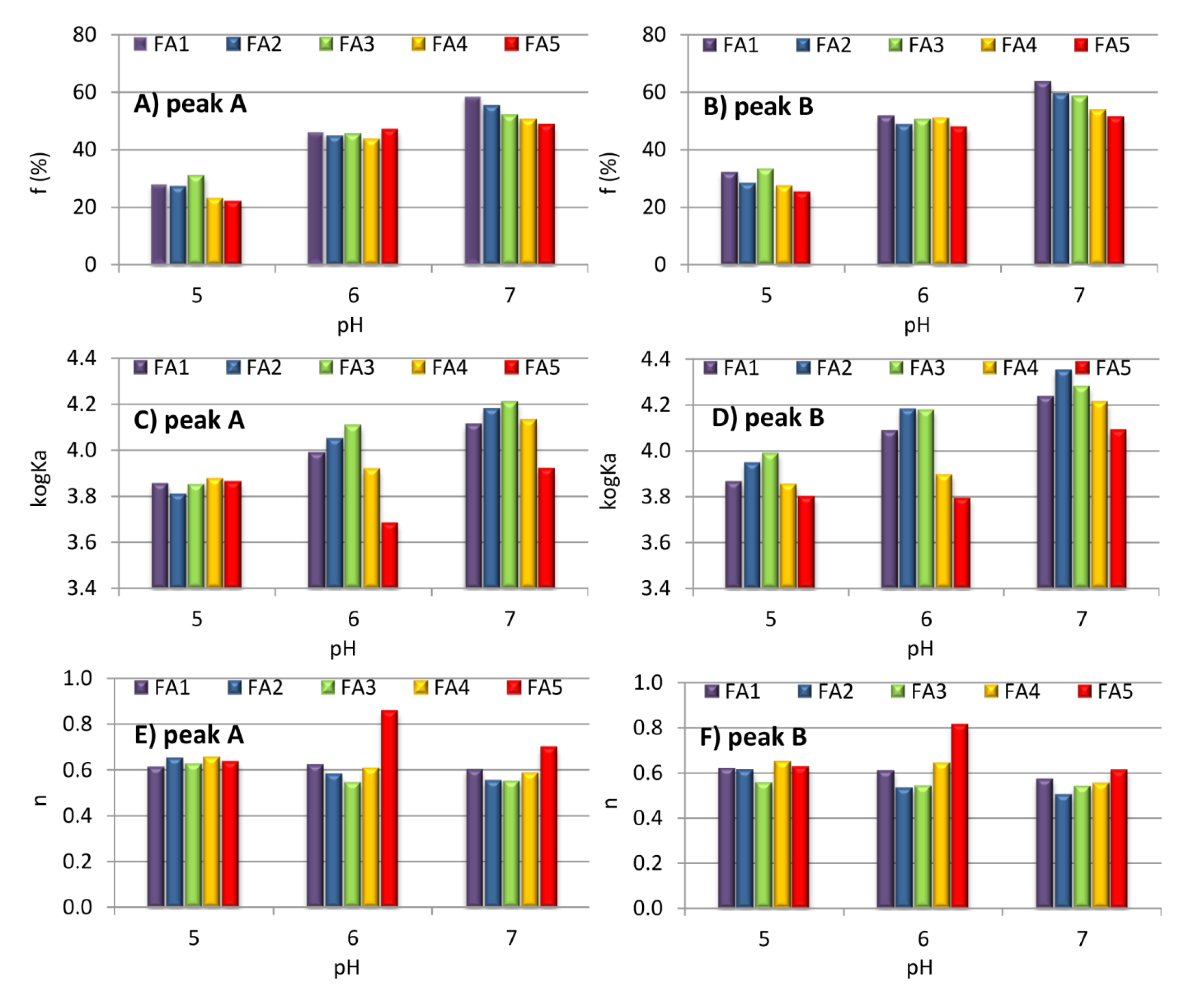
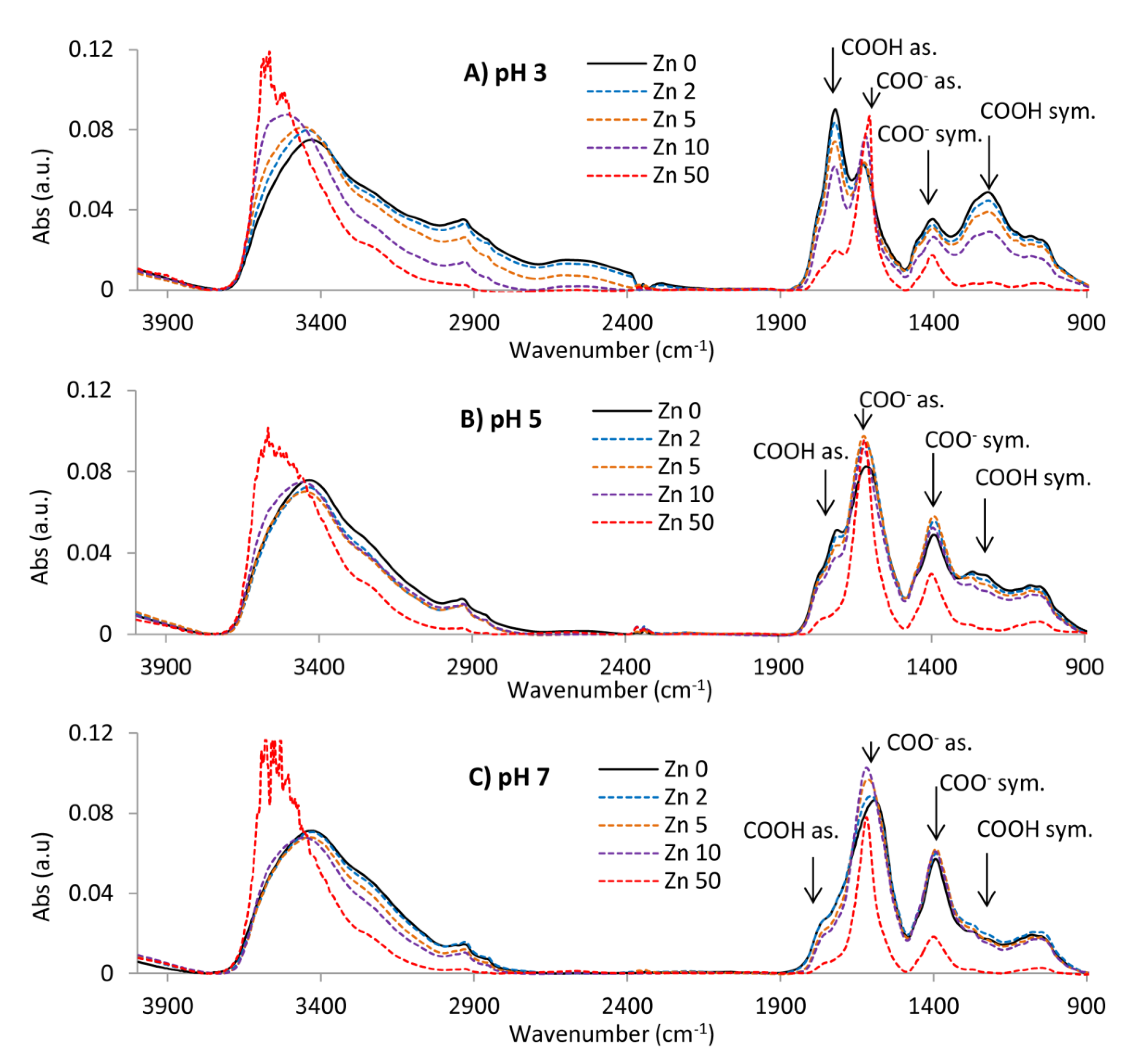
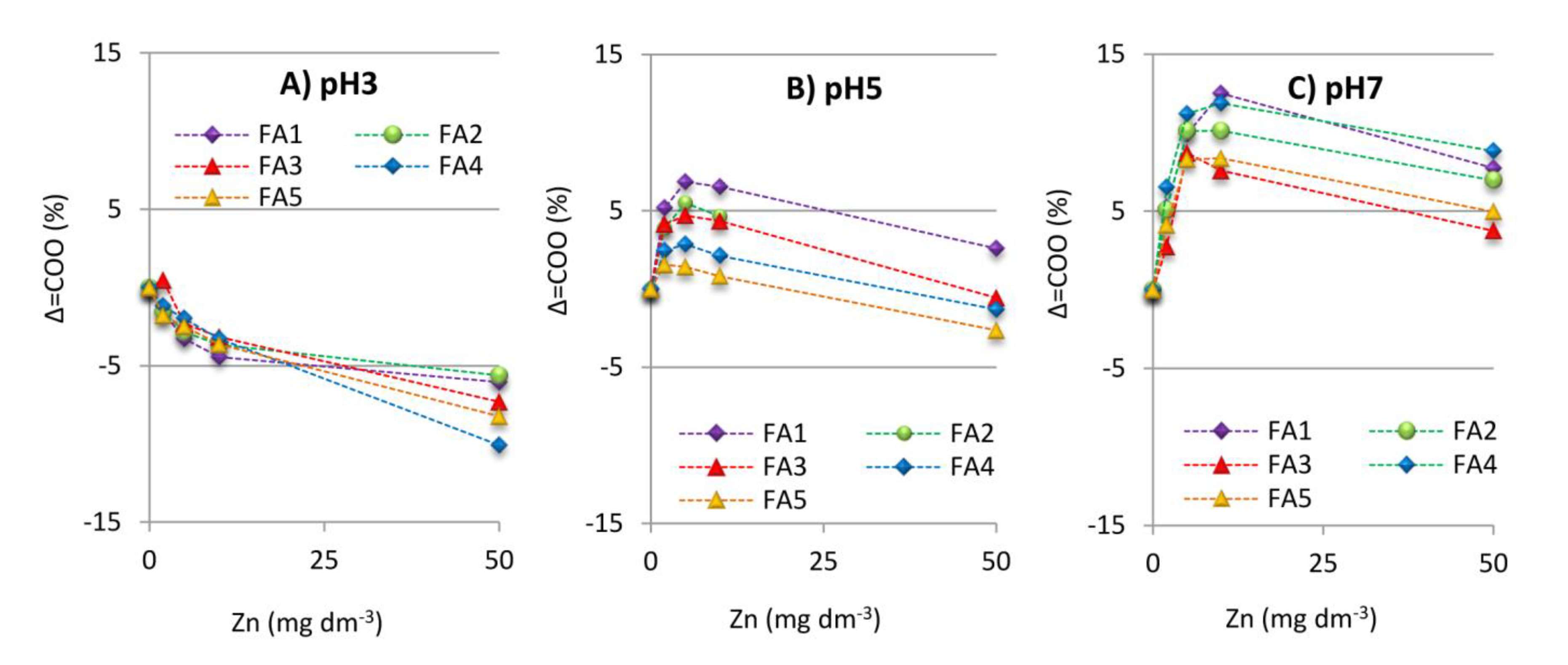
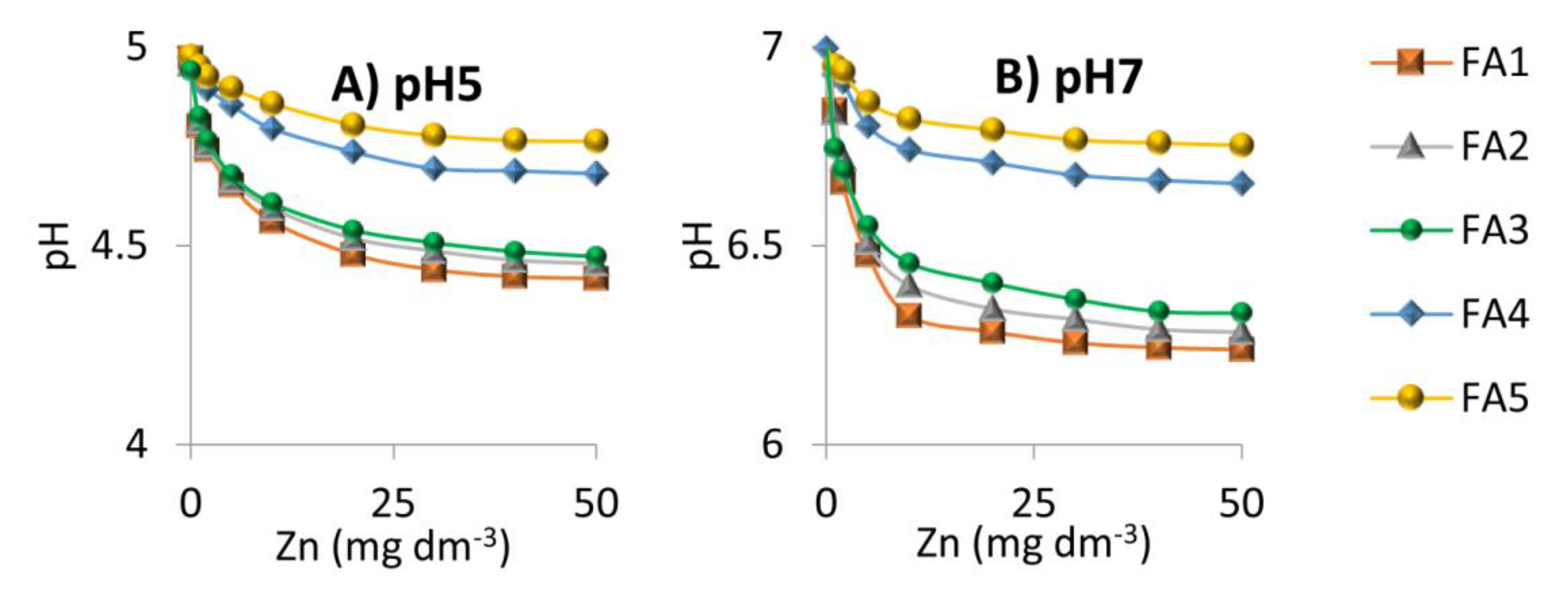
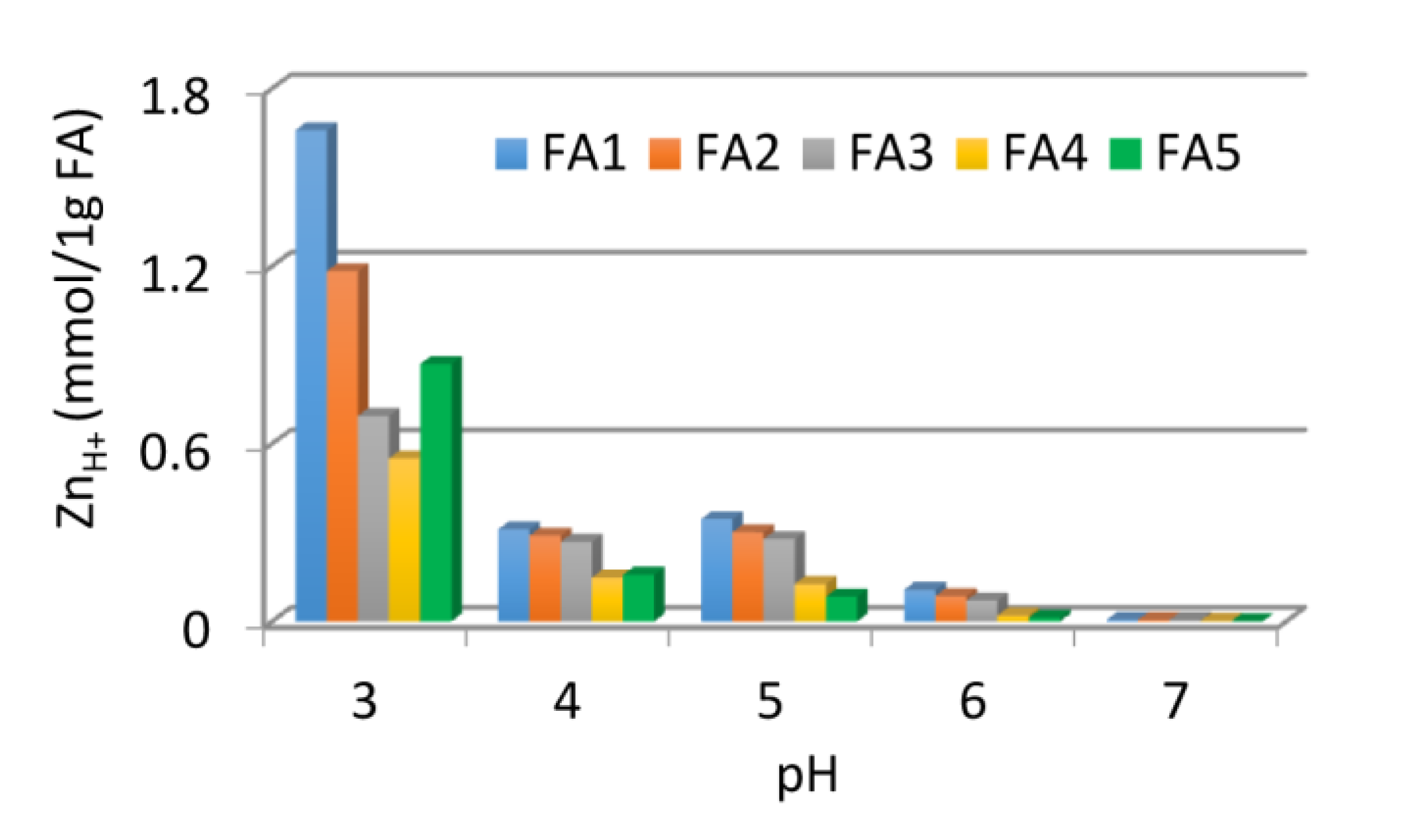
| FA No | FA Origin | H/C | O/C | O/H | ω | COOH | OH | Q465/Q665 | Q254/Q436 | Q280 | A | |
|---|---|---|---|---|---|---|---|---|---|---|---|---|
| Soil type | Soil location | d.u. | (cmol kg−1) | d.u. | (%) | |||||||
| FA1 | Haplic Fluvisol (Alluvial soil) | 51°09′N/22°59′E | 0.90 | 0.77 | 0.86 | 0.78 | 690 | 179 | 10.46 | 18.02 | 0.67 | 0.90 |
| FA2 | Haplic Chernozem (Chernozem) | 50°32′N/24°01′E | 0.94 | 0.97 | 1.04 | 1.12 | 628 | 173 | 9.07 | 14.90 | 0.60 | 0.83 |
| FA3 | Mollic Gleysol (Black Earth) | 50°22′N/23°39′E | 0.85 | 0.65 | 0.76 | 0.61 | 561 | 224 | 13.89 | 13.45 | 0.69 | 0.73 |
| FA4 | Haplic Cambisol (Brown Soil) | 51°23′N/22°35′E | 0.87 | 0.69 | 0.79 | 0.59 | 649 | 290 | 16.15 | 15.62 | 0.65 | 0.63 |
| FA5 | Stagnic Luvisol (Grey-brown soil) | 50°38′N/22°41′E | 0.91 | 0.73 | 0.80 | 0.66 | 632 | 229 | 10.36 | 12.53 | 0.64 | 1.63 |
| pH 3 | pH 4 | pH 5 | pH 6 | pH 7 | ||||||
|---|---|---|---|---|---|---|---|---|---|---|
| FI Peak A | FI Peak B | FI Peak A | FI Peak B | FI Peak A | FI Peak B | FI Peak A | FI Peak B | FI Peak A | FI Peak B | |
| FA1 | 893 | 757 | 936 | 812 | 1043 | 911 | 1044 | 942 | 1085 | 973 |
| FA2 | 817 | 681 | 801 | 690 | 873 | 780 | 895 | 818 | 898 | 834 |
| FA3 | 434 | 430 | 453 | 455 | 515 | 523 | 532 | 555 | 534 | 565 |
| FA4 | 599 | 516 | 717 | 627 | 852 | 713 | 838 | 712 | 845 | 732 |
| FA5 | 559 | 469 | 635 | 547 | 760 | 622 | 728 | 615 | 661 | 568 |
| FA1 | ||||||||||||
| A-peak | B-peak | |||||||||||
| fa | logKa | R | logKb | n | R | fa | logKa | R | logKb | n | R | |
| pH 3 | n.a. | n.a. | n.a. | n.a. | n.a. | n.a. | n.a. | n.a. | n.a. | n.a. | n.a. | n.a. |
| pH 4 | n.a. | n.a. | n.a. | n.a. | n.a. | n.a. | n.a. | n.a. | n.a. | 0.98 | 0.54 | 0.971 |
| pH 5 | 0.28 | 3.86 | 0.990 | 1.47 | 0.61 | 0.993 | 0.32 | 3.87 | 0.991 | 1.56 | 0.62 | 0.992 |
| pH 6 | 0.46 | 3.99 | 0.997 | 1.68 | 0.62 | 0.981 | 0.52 | 4.09 | 0.997 | 1.72 | 0.61 | 0.980 |
| pH 7 | 0.58 | 4.11 | 0.997 | 1.74 | 0.60 | 0.962 | 0.64 | 4.23 | 0.997 | 1.77 | 0.57 | 0.960 |
| FA2 | ||||||||||||
| A-peak | B-peak | |||||||||||
| fa | logKa | R | logKb | n | R | fa | logKa | R | logKb | n | R | |
| pH 3 | n.a. | n.a. | n.a. | n.a. | n.a. | n.a. | n.a. | n.a. | n.a. | n.a. | n.a. | n.a. |
| pH 4 | n.a. | n.a. | n.a. | n.a. | n.a. | n.a. | n.a. | n.a. | n.a. | n.a. | n.a. | n.a. |
| pH 5 | 0.27 | 3.81 | 0.989 | 1.41 | 0.65 | 0.988 | 0.28 | 3.95 | 0.984 | 1.40 | 0.61 | 0.995 |
| pH 6 | 0.45 | 4.05 | 0.995 | 1.57 | 0.58 | 0.980 | 0.49 | 4.18 | 0.992 | 1.54 | 0.53 | 0.984 |
| pH 7 | 0.55 | 4.18 | 0.998 | 1.62 | 0.55 | 0.970 | 0.59 | 4.35 | 0.995 | 1.58 | 0.50 | 0.977 |
| FA3 | ||||||||||||
| A-peak | B-peak | |||||||||||
| fa | logKa | R | logKb | n | R | fa | logKa | R | logKb | n | R | |
| pH 3 | n.a. | n.a. | n.a. | n.a. | n.a. | n.a. | n.a. | n.a. | n.a. | n.a. | n.a. | n.a. |
| pH 4 | n.a. | n.a. | n.a. | n.a. | n.a. | n.a. | n.a. | n.a. | n.a. | n.a. | n.a. | n.a. |
| pH 5 | 0.31 | 3.85 | 0.995 | 1.49 | 0.63 | 0.986 | 0.33 | 3.99 | 0.995 | 1.36 | 0.56 | 0.984 |
| pH 6 | 0.45 | 4.11 | 0.993 | 1.43 | 0.55 | 0.970 | 0.50 | 4.18 | 0.996 | 1.50 | 0.54 | 0.971 |
| pH 7 | 0.52 | 4.21 | 0.996 | 1.45 | 0.55 | 0.959 | 0.59 | 4.28 | 0.996 | 1.53 | 0.54 | 0.951 |
| FA4 | ||||||||||||
| A-peak | B-peak | |||||||||||
| fa | logKa | R | logKb | n | R | fa | logKa | R | logKb | n | R | |
| pH 3 | n.a. | n.a. | n.a. | n.a. | n.a. | n.a. | n.a. | n.a. | n.a. | n.a. | n.a. | n.a. |
| pH 4 | n.a. | n.a. | n.a. | n.a. | n.a. | n.a. | n.a. | n.a. | n.a. | n.a. | n.a. | n.a. |
| pH 5 | 0.23 | 3.88 | 0.976 | 1.43 | 0.66 | 0.992 | 0.28 | 3.85 | 0.984 | 1.42 | 0.65 | 0.985 |
| pH 6 | 0.44 | 3.92 | 0.996 | 1.85 | 0.61 | 0.969 | 0.51 | 3.90 | 0.985 | 1.72 | 0.64 | 0.952 |
| pH 7 | 0.50 | 4.13 | 0.993 | 1.58 | 0.59 | 0.974 | 0.54 | 4.21 | 0.993 | 1.56 | 0.55 | 0.969 |
| FA5 | ||||||||||||
| A-peak | B-peak | |||||||||||
| fa | logKa | R | logKb | n | R | fa | logKa | R | logKb | n | R | |
| pH 3 | 0.02 | 3.99 | 0.941 | n.a. | n.a. | n.a. | n.a. | n.a. | n.a. | n.a. | n.a. | n.a. |
| pH 4 | 0.05 | 3.83 | 0.890 | 0.88 | 0.69 | 0.954 | n.a. | n.a. | n.a. | 1.03 | 0.67 | 0.937 |
| pH 5 | 0.22 | 3.86 | 0.977 | 1.39 | 0.64 | 0.997 | 0.26 | 3.80 | 0.987 | 1.49 | 0.63 | 0.993 |
| pH 6 | 0.47 | 3.68 | 0.997 | 1.88 | 0.86 | 0.976 | 0.48 | 3.79 | 0.998 | 1.84 | 0.81 | 0.973 |
| pH 7 | 0.49 | 3.92 | 0.993 | 1.75 | 0.70 | 0.974 | 0.52 | 4.09 | 0.996 | 1.67 | 0.61 | 0.976 |
| NZn/g FA pH 5 | NZn/g FA pH 6 | NZn/g FA pH 7 | |||
|---|---|---|---|---|---|
| faA pH 5 | 0.84 | faA pH 6 | 0.05 | faA pH 7 | 0.91 |
| faB pH 5 | 0.80 | faB pH 6 | 0.39 | faB pH 7 | 0.97 |
| logKaA pH 5 | −0.58 | logKaA pH 6 | 0.73 | logKaA pH 7 | 0.66 |
| logKaB pH 5 | 0.65 | logKaB pH 6 | 0.86 | logKaB pH 7 | 0.76 |
| nA pH 5 | −0.47 | nA pH 6 | −0.60 | nA pH 7 | −0.65 |
| nB pH 5 | −0.49 | nB pH 6 | −0.73 | nB pH 7 | −0.56 |
© 2020 by the authors. Licensee MDPI, Basel, Switzerland. This article is an open access article distributed under the terms and conditions of the Creative Commons Attribution (CC BY) license (http://creativecommons.org/licenses/by/4.0/).
Share and Cite
Boguta, P.; Sokołowska, Z. Zinc Binding to Fulvic acids: Assessing the Impact of pH, Metal Concentrations and Chemical Properties of Fulvic Acids on the Mechanism and Stability of Formed Soluble Complexes. Molecules 2020, 25, 1297. https://doi.org/10.3390/molecules25061297
Boguta P, Sokołowska Z. Zinc Binding to Fulvic acids: Assessing the Impact of pH, Metal Concentrations and Chemical Properties of Fulvic Acids on the Mechanism and Stability of Formed Soluble Complexes. Molecules. 2020; 25(6):1297. https://doi.org/10.3390/molecules25061297
Chicago/Turabian StyleBoguta, Patrycja, and Zofia Sokołowska. 2020. "Zinc Binding to Fulvic acids: Assessing the Impact of pH, Metal Concentrations and Chemical Properties of Fulvic Acids on the Mechanism and Stability of Formed Soluble Complexes" Molecules 25, no. 6: 1297. https://doi.org/10.3390/molecules25061297
APA StyleBoguta, P., & Sokołowska, Z. (2020). Zinc Binding to Fulvic acids: Assessing the Impact of pH, Metal Concentrations and Chemical Properties of Fulvic Acids on the Mechanism and Stability of Formed Soluble Complexes. Molecules, 25(6), 1297. https://doi.org/10.3390/molecules25061297





